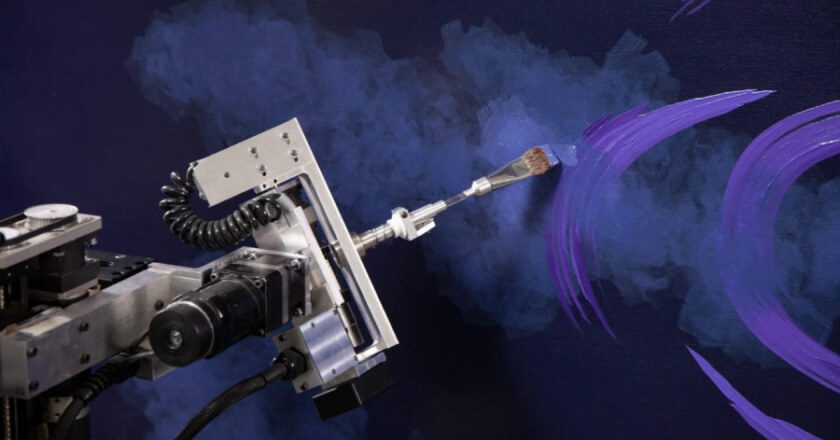Get Inspired
Build the life you love. Learn more about fusioneering:

Posted on November 28, 2022 in Art History
How does a single color affect the colors around it? Perhaps the question seems odd, though it is a thought that has wracked the art world since the study of artistic matters began. It was a chief concern of the Impressionist movement, and also part of the inspiration behind Paul Kirby and Dulcinea’s painted work of a staggering 44,943 brushstrokes: Impressionist.
Related: How Paul and Dulcinea Make a Painting
On a visit to the Getty Museum in Los Angeles, Paul was transfixed by a painting of a haystack in winter. It was a Monet, and a subject he had painted many times over. In this particular rendition, Paul found himself enchanted by the snow on the ground and its magical, deep, painterly quality.
It was Claude Monet’s goal to not render the world as it actually was, but instead to “paint the way a bird sings.” As he and his peers were shaping the art movement of Impressionism, they sought to explore moods and feelings crafted from transformative relationships between light and color. Monet famously painted a single set of haystacks 25 times over seven months, often taking a dozen or so canvases into the field with him at a time. Why would he do this? Because every time Monet looked at the hay, the shifting sunlight would color the stack and the surrounding fields in entirely distinct and novel ways. Monet had but only a few pigments at his disposal, but was able to capture the many colors and moods of the haystacks through the use of the tricks contrast plays on the eyes.
When juxtaposed against each other, different colors take on an entirely “new” appearance. The contrast between different shades creates a relationship between colors wherein each individual color becomes something new within the whole. This is how pixel screens – like your television or whatever form of monitor you’re reading now–can make images that can look like any and every color… even though they’re composed of only different values of red, green, and blue. Modern printing works the same way, creating myriad colors with only tiny spots of cyan, magenta, yellow, and black. This effect was harnessed by the Neo-impressionist artists Georges Seurat and Paul Signac, in a technique that would be coined “Pointillism.” Many dots of color, come together to take on a new life.
This style and mindset would be used in the creation of Impressionist. Appropriately, Dulcinea was given a new form of brushstroke for this painting, referred to as “point.”
Read More: What is Impressionism?
But how would the structure of Impressionist come to be? True to his code of having Dulcinea “never copy” from anything else, Paul needed an emergent design for Dulcinea to apply her new brushstroke and painting style to.
While on an artists’ study trip to Italy, a fellow artist involved in movie VFX (the field of creating computer-generated visual effects) brought-up Brownian motion and how Perlin noise was employed to create CGI textures.
Perlin noise is a type of procedurally generated texture used in computer graphics. It was developed by Ken Perlin after his work on the 1982 film Tron, in response to Perlin’s frustration with the overly “machine-like” look of the day’s computer-generated imagery. The effect utilizes Brownian motion – the algorithmic simulation of particles randomly moving through a void – to generate realistic-looking, random visual textures. These textures could be used on any computer-generated item or environment, such as a dusty field, a rock wall, or an alien creature’s skin. For his algorithm, Perlin received the 1997 Academy Award for Technical Achievement. The Perlin noise effect is frequently used in graphics generation of all types, from blockbuster films to video games.
Fascinated by the idea, Paul used a fractional Brownian motion (fBm) algorithm to generate the complex textural pattern that Dulcinea would use for her pointillism brushstrokes. Over the course of two full days, Dulcinea would take three passes at the canvas using twenty-four different colors. The computer-generated pattern, along with the three passes, many colors, and 44,943 points of paint, come together to create an image with great layers, depth, and texture.
Impressionist is a textural tapestry of color and its transformative abilities. What do its painterly forms make you feel? How do its colors come together to evoke something unseen? Gaze into the spots of light on the canvas and discover the answers for yourself.
Looking for more art and science inspiration – and to follow an inspirational person? Follow The Kirby Foundation on Instagram and Facebook, and join the mailing list to ensure you never miss an update!
Are you interested in hearing the complete story of Paul and Dulcinea? Watch the video (nominated for Best Short Film at the 2021 Vail and Portland Film Festivals) for more info.
Want to be the first to know about every exciting new project at the Kirby Foundation?
Join Our Mailing ListBuild the life you love. Learn more about fusioneering:
Why pick which passion you should follow? Fusioneering allows you to cultivate many interests into something innovative and revolutionary.

Meet Paul and explore how blending your interests can empower you to follow your enthusiasm and bring your passions to life.